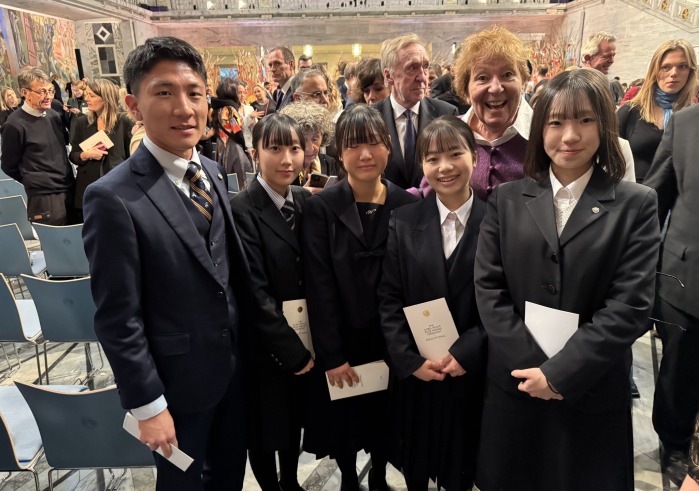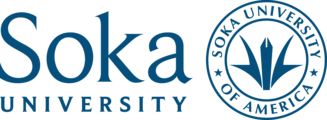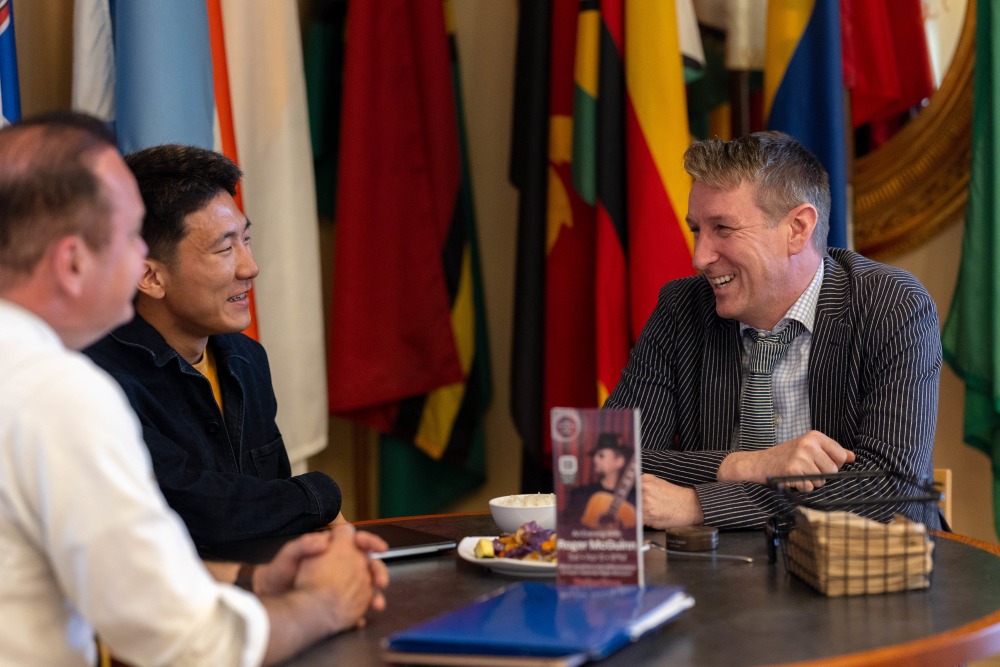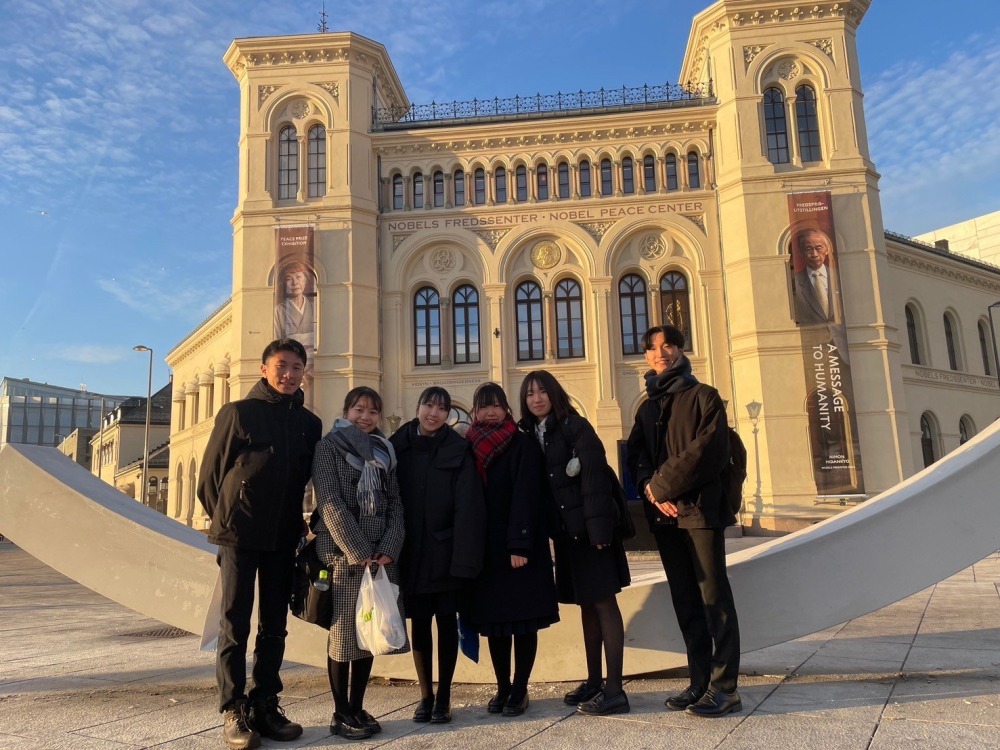From SUA to Oslo: Daiki Katsukawa ’26 Champions a Future Free of Nuclear Weapons

When Daiki Katsukawa ‘26 first stood before the U.N. Conference on Disarmament as a high school student, he never imagined his path would lead to Oslo’s City Hall, where survivors of history’s only nuclear attacks would receive humanity’s highest recognition for peace.
Now a junior at Soka University of America, Katsukawa speaks with quiet conviction about his mission. “We all have loved ones who matter deeply to us,” he said. “Nuclear weapons do not distinguish between people. Whether you are a leader or not, the path forward is clear: we must work to deter the use of nuclear weapons to protect the people we care about.”
Katsukawa’s path to Oslo began in Osaka, Japan, where a high school project would shape his life’s direction. While attending Kansai Soka High School, he discovered the Hiroshima and Nagasaki Peace Messengers, a youth-led organization dedicated to amplifying the voices of atomic bomb survivors and advocating for nuclear disarmament.
His selection as a Peace Messenger soon led to his first diplomatic experience: traveling with a delegation of high school Peace Messengers to the U.N. Conference on Disarmament in Geneva. Though their observation of the conference lasted just 30 minutes, the human scale of international diplomacy left a lasting impression.
“I used to think that the U.N. was such a huge, impersonal agency,” said Katsukawa. “Some countries’ delegations even waved at us. It was very different from what I’d expected.”
Through informal conversations with ambassadors from around the world, he learned that though many countries support the abolition of nuclear weapons, others still subscribe to the doctrine of nuclear deterrence. But it was on a visit to the Hiroshima Peace Memorial Museum that the true cost of nuclear weapons shifted from theory to something painfully real for Katsukawa. In the museum’s quiet halls, he encountered an artifact that would haunt him: a scorched lunch box that belonged to Shigeru, a 13-year-old boy who died clutching his uneaten meal in the aftermath of the Hiroshima bombing. “I felt this could have been me,” Katsukawa recalled.
The impact of that moment deepened when he met a hibakusha (atomic bombing survivor) whose warm welcome belied her horrific testimony. Her strength in sharing such painful memories revealed to Katsukawa the true significance of his role as a Peace Messenger. “Although my contributions may seem small,” he said, “I began to see my role as helping to preserve and share these stories humanely and impactfully, ensuring they are never lost to history.”
Moved by these experiences, Katsukawa wrote to SUA founder Daisaku Ikeda about his selection and activities as a Peace Messenger. To his surprise, Ikeda responded with a short but inspiring message: “I’m delighted!”
This warm encouragement would prove crucial in the months ahead. When the COVID-19 pandemic shut the world down, Katsukawa was in the midst of applying for admission to SUA. Despite the global upheaval, he began the Extended Bridge Program for international students in 2021, which he successfully completed before continuing as an undergraduate student in 2022.
“I never could have imagined how my journey would unfold,” said Katsukawa, “but Mr. Ikeda’s encouragement motivates me today as I live and learn at SUA, a university founded on his vision of peace.”
Learning to Lead and Traveling for Peace
That vision would soon intersect with one of the world’s most prestigious peace initiatives. In January 2023, during Katsukawa’s first year at SUA, the university launched a partnership with the Norwegian Nobel Institute. The Nobel Seminars brought Dr. Asle Toje, deputy leader of the Norwegian Nobel Committee, to campus for several days of intensive dialogue about peace-building.
During his visit, Toje delivered a university talk, “The Nobel Peace Prize: Can It Influence World Peace?”, and met with students from two learning clusters. For Katsukawa, the timing couldn’t have been more fortuitous.
In their final presentations, students in Professors Tetsushi Ogata’s and Alexander Harang’s learning clusters nominated organizations for the Nobel Peace Prize. Katsukawa, drawing on his own experience, nominated the Peace Messengers. Toje, who observed the presentations, later said he found the students’ choices impressive enough to voice them to the Norwegian Nobel Committee upon his return to Oslo.
The deputy leader’s perspective on peace and disarmament challenged Katsukawa to think more deeply about his own role. Rather than simply moving on from the presentation, he reached out to the Hiroshima and Nagasaki Peace Messengers with suggestions for strengthening its program. He also shared news of his Nobel Prize nomination during Toje’s visit.
That summer, while visiting Japan during break, Katsukawa met with Peace Messengers alumni. Back on campus that August, he received an unexpected phone call: the Committee of Hiroshima and Nagasaki Peace Messengers was resuming their pre-pandemic work in Norway. Their previous visits to Oslo in 2018 and 2019 had laid groundwork that needed to be rebuilt.
The committee had a request: would Katsukawa and one other alum visit Oslo as the organization’s representatives? Their mission would include submitting materials about the Peace Messengers to the Nobel Committee. During this visit, Katsukawa met again with Toje for a candid discussion about the organization’s future. “I shared about the Peace Messengers’ strengths, weaknesses, and challenges,” said Katsukawa. “I was quite honest about the ways I think the organization can improve.”
The Peace Messengers asked Katsukawa to return in summer 2024, this time to chaperone for three high school members. He embraced the role, planning every detail of their immersion in peace work — from transit and hotels to a packed schedule of meetings with key organizations.
The students met with representatives from Changemakers, No to Nuclear Weapons, the International Campaign to Abolish Nuclear Weapons, and International Physicians for the Prevention of Nuclear War. At a high school in Oslo, they engaged in dialogue with students about peace and disarmament, bridging cultures through shared concern for the future.
“They became more confident in speaking up for what they believe in and talking about these important global issues,” Katsukawa reflected, watching his young charges grow from nervous visitors to passionate advocates.
The Nobel Peace Prize Announcement: A Moment of Hope
On October 11, 2024, the Norwegian Nobel Committee revealed its decision: the 2024 Nobel Peace Prize would go to Nihon Hidankyo, the movement of atomic bomb survivors from Hiroshima and Nagasaki whose testimonies helped establish the “nuclear taboo” — the international norm that stigmatized the use of nuclear weapons.
The committee’s press release acknowledged a crucial truth: the hibakusha would not be here forever to share their testimony. “But with a strong culture of remembrance and continued commitment,” the committee noted, “new generations in Japan are carrying forward the experience and the message of the witnesses. They are inspiring and educating people around the world.”
For Katsukawa, this recognition brought new responsibilities. He was asked to coordinate logistics and translate for the Peace Messengers youth delegation attending the award ceremony. His role would include translating the experiences of five hibakusha at a series of events, including one at Oslo University.
Returning to Oslo in December 2024 — his third visit to the Norwegian capital in just two years — Katsukawa felt the weight of his role more deeply than ever. He wasn’t just translating words; he was bridging generations, helping survivors share their stories on the world stage. “Throughout this time, I wondered how I could manage it all,” said Katsukawa. “I was facing many challenges, and creating the itinerary and communicating with everyone on top of my academic work was overwhelming. I am deeply grateful to my friends who kept believing in me and said, ‘You got this, Daiki.’”
While the Peace Prize ceremony itself was a highlight, Katsukawa found deeper meaning in watching the high school students he mentored. Each one cried during their farewell before returning to Japan, committing themselves to creating change in their own communities. Their tears reflected a transformative truth: the survivors’ stories had found new voices to carry them forward.
The Critical Role of Youth
Looking toward graduation in 2026, Katsukawa remains uncertain about his exact path but clear about his purpose. His time at SUA has taught him two crucial lessons: how to give his all even in challenging circumstances, and how to recognize the network of support that makes such work possible.
“Young people often struggle with comparing themselves to others, as I do,” Katsukawa said. “However, when I focus on the actions I can take, my perspective shifts entirely. For me, the key is striving to become a better person, even in difficult circumstances, so that I can inspire others facing similar struggles.”
“We can collectively build the foundation for a more peaceful world by starting small and encouraging one another,” he said. “Young people don’t just have a role in creating a peaceful world — we have a responsibility to ensure these stories are never forgotten.”


